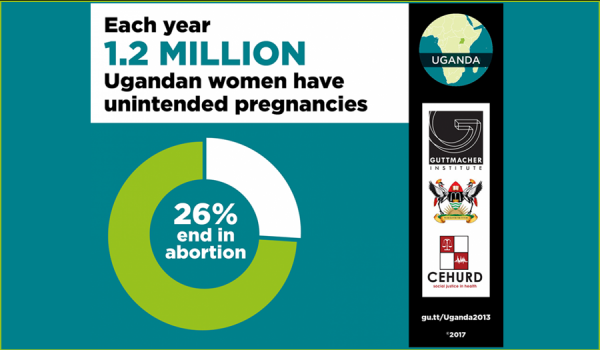
Elena Prada, Lynn M Atuyambe, Nakeisha M Blades, Justine N Bukenya, Christopher Garimoi Orach, Akinrinola Bankole
PLoS One 2016;11(11). DOI:10.1371/journal.pone.0165812
In 2003, 294,000 induced abortions were estimated to occur each year in Uganda. In the first research on abortion incidence since then, data from 418 health facilities were used in 2013 to estimate the number and rate of induced abortion nationally and by major regions. The methodology used in both studies was comparable and permitted an assessment of trends between 2003 and 2013.
In 2013, an estimated 314,304 induced abortions occurred and an estimated 128,682 women (almost one in three) were treated for abortion complications, compared to 294,000 and 110,000 in 2003, respectively. The national abortion rate in 2013 was 39 abortions per 1,000 women aged 15–49, down from 51 in 2003. Regional variation in abortion rates was very large, however, from as high 77 per 1,000 women aged 15–49 in Kampala region, to as low as 18 per 1,000 women in Western region. The overall pregnancy rate declined from 326 to 288, but the proportion of unintended pregnancies increased from 49% to 52%.
The authors conclude that the majority of pregnancies to Ugandan women were still unintended. And although the use of modern contraception has increased, it seems a large proportion of women/couples are having difficulty practising contraception effectively.
As regards abortion, according to the Guttmacher Institute’s press release about the article, although Ugandan law explicitly allows abortion to save a woman’s life and the 2012 National Policy Guidelines and Service Standards for Sexual and Reproductive Health and Rights permit abortion in cases of fetal anomaly, rape and incest, and HIV, in practice, legal abortion is both difficult to obtain and to provide. The country’s abortion laws and policies are inconsistently interpreted by law enforcement officials and the judicial system, and many providers and women remain unaware of the circumstances under which abortion is legal. As a result, most abortions in Uganda are clandestine procedures, which are often unsafe. Moreover, notwithstanding the Ugandan government’s efforts to improve post-abortion care services, stigma and fear of mistreatment are significant barriers for many women in need of these services.



